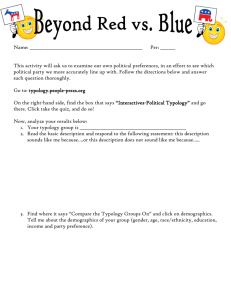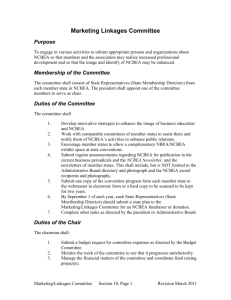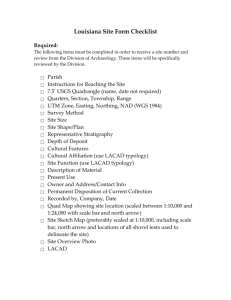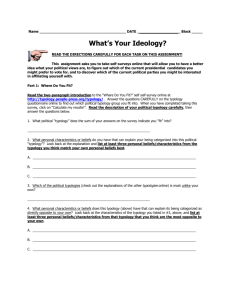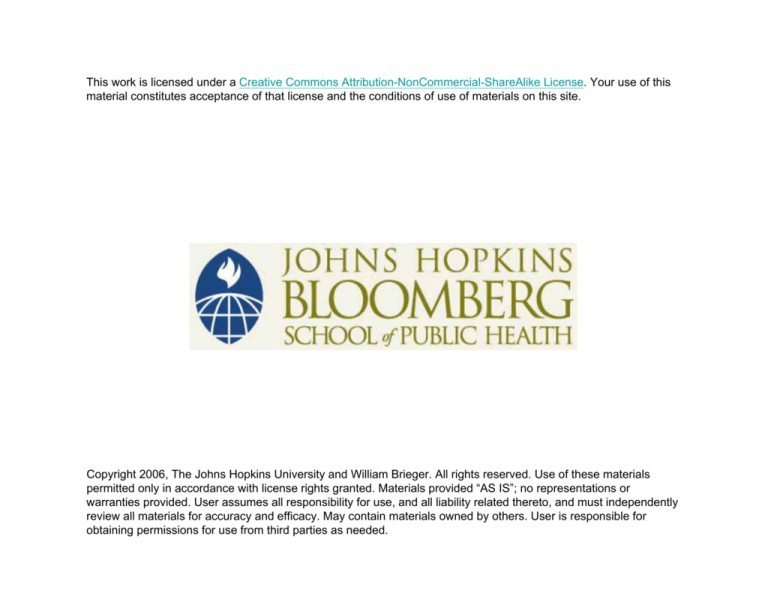
This work is licensed under a Creative Commons Attribution-NonCommercial-ShareAlike License. Your use of this
material constitutes acceptance of that license and the conditions of use of materials on this site.
Copyright 2006, The Johns Hopkins University and William Brieger. All rights reserved. Use of these materials
permitted only in accordance with license rights granted. Materials provided “AS IS”; no representations or
warranties provided. User assumes all responsibility for use, and all liability related thereto, and must independently
review all materials for accuracy and efficacy. May contain materials owned by others. User is responsible for
obtaining permissions for use from third parties as needed.
Definitions of Community
William R. Brieger, MPH, CHES, DrPh
Johns Hopkins University
1
Section A
Community
2
Definitions and change processes
3
What Is a Community?
Ù A group of people living in the same
defined area sharing the same basic
values, organization and interests
(Rifkin et al, 1988)
Ù An informally organized social entity
which is characterized by a sense of
identity (White, 1982)
Continued
4
What Is a Community?
Ù A population which is geographically
focused but which also exists as a
discrete social entity, with a local
collective identity and corporate
purpose (Manderson et al, 1992)
5
Community Components
Communities Are People Sharing Values and Institutions
Ù Locality
Ù An interdependent social group
Ù Interpersonal relationships
– Expressed through social
networks, and …
Ù A culture that includes values, norms,
and attachments to the community as
a whole as well as to its parts
6
Community Diagnosis
A Review of Systems
Ù Social System
– Basic units and roles
•
Associations
•
Institutions
•
Family structure, etc
7
The Social System
Communities Are Built on Social Capital
Ù Social networks have value—just like
physical capital—reciprocity “pays off”
Ù Social capital refers to the connections
among individuals
Ù Civic virtue becomes powerful when
embedded in a dense network of
reciprocal social relations
Continued
8
The Social System
Communities Are Built on Social Capital
Ù A community’s social and economic
resources are embedded in social
networks
Ù Social capital has “externalities” that
go beyond individual members—
affects wider community
9
Community Diagnosis
A Review of Systems
Ù Political System
– Power relations
– Leadership structure
– Subgroups
– Disenfranchised groups
– Formal and informal leadership
Continued 10
The Political System
Ù Formal and informal
leadership
Ù Decision making
processes
Ù Participation
Ù Constraints and
controls
Ù Accountability
Source: The Basics
11
Community Diagnosis
A Review of Systems
Ù Cultural System
– Basic beliefs and ways of life
including technologies
Ù Economic
– Resource base, ways of earning a
living, distribution of resources
Continued 12
Community Diagnosis
A Review of Systems
Ù Geographic
– Use of space, location of valued
resources in that space
– Formal
• Presence or absence of
specific characteristics
Continued 13
Community Diagnosis
A Review of Systems
Ù Geographic
– Functional
• Flows and interactions of
people, goods, information
– Administrative
• Town, zone, or other
boundaries
14
Maps Use the Geographic System
to Help Diagnose the Community
Ù Location of resources
Ù Distribution of population
Ù Prevalence of health problems
15
Involve the community
in drawing and
interpreting maps
16
Framework for Studying
Community
Ù Community typology framework
– By Warren and Warren
– Build on four characteristics
• Identify
• Integration
• Group norms
• External linkages
17
Community Typology Framework:
Four Community Characteristics
1. Identity
– How much do people feel they
belong to a community and share
a common destiny with others?
– Is there a sense of consciousness
about what their community is,
where it is spatially?
18
Identity
Ù When there is strong identity, people
– Generally do get along with each
other
– Share the same values and
interests
Continued 19
Identity
Ù When there is strong identity, people
– Feel free to leave their children
with neighbors when they go to
market (trust)
– Share a sense of place—
assessment that their
neighborhood is distinctive based
on its unique characteristics
20
Sense of Communal History
Enhances Identity
Indian
temples
have
depicted a
shared
history for
hundreds of
years
21
Community Characteristics
2. Integration
– How often and with what number
of neighbors do people visit and
interact on the average during a
period of one year?
Continued 22
Community Characteristics
2. Integration
– What brings people together?
• Do they work on common
causes?
• Do they socialize together?
– Is there a sense of cohesion that
brings people together for
activities, help, projects?
23
Cohesion/Integration
Ù When there is cohesion, people …
– Belong to an association or club
inside this community
– Relate/go talk with their neighbors
at least once a week
– Attend a ceremony organized by
their neighbor
24
The Market
A Good Place to Observe Integration and
Interaction
Ù
Ù
Ù
Ù
Economic status
Nutritional options
Social interaction
Communication networks
25
The market
26
A Cohesive Community Enjoys
Festivals Together
Gelede Festival in Southwestern Nigeria
27
Tulalip Indians in Washington State celebrate the
first salmon of the season
28
Community Characteristics
3. Group orientation
– How important is group,
community welfare compared with
the needs and rights of
individuals?
– Are decisions made with
community in mind?
– How strong are norms? Do they
enhance social control?
29
If There Are Strong Norms,
One May See …
Ù A neighbor challenging any children
who are playing in the street instead of
going to school
Ù A neighbor criticizing any child who
shows disrespect for an elder
Ù A neighbor trying to settle a fight that
broke out in front of his or her house
Continued 30
If There Are Strong Norms,
One May See …
Ù A neighbor disciplining anyone who
throws refuse in the street
Ù A neighbor complaining to the local
government if it wanted to close down
a local primary school
31
Community Characteristics
4. Linkages
– What channels exist for community
members to contact outside
groups and resources?
– What channels exist for outside
groups and agencies to reach the
community?
Continued 32
Community Characteristics
4. Linkages
– Do community members belong to
outside groups?
– Do they bring news about the
larger community back into the
neighborhood?
33
Linkages—Resources
Ù When communities have strong
external links, members:
– Seek help from a local government
agency for solving a community
problem
Continued 34
Linkages—Resources
Ù When communities have strong
external links, members:
– Raise funds to carry out a
community project
• Including seeking outside
supporters
– Belong to national or regional
organizations, voluntary or
professional associations
35
Community generated funds and links to external technical
assistance address water supply needs
36
When There Are Few Linkages to
Outside Agencies, Including
Government
Ù Community
resources such
as clinics are
not maintained
Ù Drug supplies
are irregular
37
By belonging to
branches of
national
associations
community
members learn
new ideas
38
Hometown Associations
Social Capital with Linkages
Ù Help rural migrants
to the big city
Ù Raise funds for
hometown projects
Ù Intercede with
state or national
agencies and
politicians on
behalf of
community
39
Typology: Different Combinations
of Characteristics
Ù An integral community
– Strong identity, integration,
linkages
– A cosmopolitan as well as a local
center; individuals are in close
contact; they share many
concerns; they participate in
activities of the larger community
Continued 40
Typology
Ù A parochial community
– Strong identity, integration, weak
linkages
– A community having a strong ethnic
identity or homogeneous character;
self-contained, independent of the
larger community; has ways to
screen out what does not conform
with its own norms
Continued 41
Typology
Ù A diffuse community
– Strong identity only
– Often homogeneous setting
ranging from a new subdivision
(GRA) to a new inner-city housing
estate or project
Continued 42
Typology
Ù Diffuse
– Many things in common
– No active internal life
– Little local involvement with
neighbors
Continued 43
Typology
Ù A stepping-stone community
– Weak identity, strong interaction,
links
– An active neighborhood
– People participate in neighborhood
activities not because they identify
with the neighborhood but often to
“get ahead”
Continued 44
Typology
Ù A transitory community
– Strong linkages only
– A neighborhood where population
change has been or is occurring
Continued 45
Typology
Ù Transitory
– Often breaks up into little clusters
of people—frequently “old timers”
and newcomers are separated
– Little collective action or
organization takes place
Continued 46
Typology
Ù Anomic
– Weak on all counts
– Really a non-neighborhood
– Highly atomized, no cohesion
Continued 47
Typology
Ù Anomic
– Great social distance between
people
– Lack in the capacity to mobilize for
common action from within
48
Communities can be rural
49
Communities can be spread across the mountains
50
Communities can be urban: weak identity
51
Urban communities can have active street life
52
Section B
A Second Perspective and
Framework:
Offensive, Defensive, and Hidden
Communities
53
Another Perspective
Community on the Offensive
Ù Has actively identified problems
– Environmental concerns
– Lack of public services
Ù Highly visible through community-wide
cultural festivals
– Has media access to get its needs
known more widely
Continued 54
Another Perspective
Community on the Offensive
Ù Intervention takes the form of
collective action by the people
themselves
Ù Class
– There is an active middle class with
time, resources, and contacts to
enable community action
55
Defensive Community
Ù Problems/issues of concern mainly
local neighborhood
– More reactive, not proactive
Ù Best reached through neighborhood
groups
Continued 56
Defensive Community
Ù Intervention
– Often waiting for solution from
above
Ù Class
– Conscientious working-class
neighborhood
– Strong group norms, don’t rock the
boat
57
An Ancient Walled City
May Be “Defensive”
58
Hidden Community
Hard to Reach
Ù Poverty is a pervasive problem such
that other issues are not well
articulated
Ù Few group or community
activities/occasions
– Mostly personal contact to meet
members
Continued 59
Hidden Community
Hard to Reach
Ù Intervention
– Mostly on an individual casework
basis
Ù Class
– Economically underprivileged
60
Slums Lie Hidden behind Modern
Urban High Rise Buildings
61
As a Unit of Identity
Communities Define Themselves
Ù Boarders are determined by insiders
Ù Membership is mutually decided and
recognized
Ù May be compact
Ù May be spread widely over several
miles
Ù Does not necessarily conform to lines
on a map
62
Community Identity
Is Part of Local Culture—For Example, The Maasai
Ù All natural resources and living things
have traditional names, special uses
(plants), and special cultural roles for
cultural ceremonies
Ù All spirituality of human living is
believed by the Maasai to be derived
from the Mother Earth
Continued 63
Community Identity
Is Part of Local Culture—For Example, The Maasai
Ù Myths, legends, and tales about land
and the environment are narrated in a
sanctified manner
Ù Aridity of the land and environment is
seen by the Maasai as a severe
punishment by the Creator
– A sign of annoyance for the
destruction of the environment
64
Help preparing the roof
65
The Maasai
A Community May Be Mobile
Ù Pastoralism is part of creation
– Maasai believe the tilling of land is
a curse, an abuse to Mother Earth
Ù Marsh swamps and wells are sacred,
no settlements allowed to be created
at a radius of 5 km2 from these
sources
Continued 66
The Maasai
A Community May Be Mobile
Ù The ecosystem can be destroyed
when the aforesaid traditional but
complementary, threads
Ù The new concept of land ownership is
alien
67

